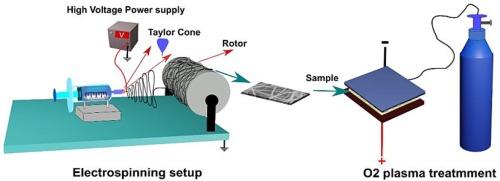等离子体处理的双金属纳米纤维作为灵敏的 SERS 平台和深度学习模型,用于抗生素的检测和分类。
IF 4.6
2区 化学
Q1 SPECTROSCOPY
Spectrochimica Acta Part A: Molecular and Biomolecular Spectroscopy
Pub Date : 2024-11-10
DOI:10.1016/j.saa.2024.125417
引用次数: 0
摘要
设计一种灵敏度高、成本效益高的 SERS 基底对于探测实际现场环境中痕量浓度的分析物至关重要。本研究报告介绍了氧气(O2)等离子体处理双金属纳米纤维作为灵敏 SERS 平台的制作过程。与传统的纳米纤维 SERS 平台相比,所提出的等离子体处理双金属纳米纤维 SERS 平台具有高灵敏度和可重复性的特点。此外,双金属纳米粒子的使用提供了一种协同效应,有助于电磁和化学增强 SERS 性能,等离子体处理有助于控制嵌入纳米粒子(NPs)与分析物的接触,从而提高了拟议技术的整体灵敏度。利用标准拉曼活性探针分子--1,2-双(4-吡啶基)乙烯(BPE)和罗丹明-6G(R6G),估计拟议传感平台的检测限(LOD)和定量限(LOQ)分别为 3.8 nM 和 11.6 nM。经计算,所设计传感平台的增强因子(EF)为 ∼108,最大信号变化率为 5%。通过检测家禽养殖场广泛使用的两种抗生素--氟康唑(FLU)和林可霉素(LIN),实现了所设计 SERS 底物的适用性。此外,还采用了深度学习模型--人工神经网络(ANN),对混合样品中的分析分子进行有效分类。本文章由计算机程序翻译,如有差异,请以英文原文为准。

Plasma treated bimetallic nanofibers as sensitive SERS platform and deep learning model for detection and classification of antibiotics
Design of a sensitive, cost-effective SERS substrate is critical for probing analyte in trace concentration in real field environment. Present work reports the fabrication of an oxygen (O2) plasma treated bimetallic nanofibers as a sensitive SERS platform. In contrast to the conventional nanofiber-based SERS platform, the proposed plasma-treated bimetallic nanofibers-based SERS platform offers high sensitivity and reproducibility characteristics. On top, the use of bimetallic nanoparticles provides a synergistic effect, contributing to both electromagnetic and chemical enhancement to SERS performance and the plasma treatment contributes to the controlled exposure of the embedded nanoparticles (NPs) to the analyte thereby enhancing the overall sensitivity of the proposed technique. With standard Raman active probe molecules – 1,2-bis(4-pyridyl) ethylene (BPE) and rhodamine-6G (R6G) the limit of detection (LOD) and the limit of quantification (LOQ) of the proposed sensing platform are estimated to be 3.8 nM and 11.6 nM respectively. The enhancement factor (EF) of the designed sensing platform is calculated to be ∼108 with a maximum signal variations of 5 %. The applicability of the designed SERS substrate has been realized through detection of two antibiotics – fluconazole (FLU) and lincomycin (LIN) widely used in poultry farms. Furthermore, a deep learning model – artificial neural network (ANN) has been implemented for effective classification of the analyte molecules from a mixed sample.
求助全文
通过发布文献求助,成功后即可免费获取论文全文。
去求助
来源期刊
CiteScore
8.40
自引率
11.40%
发文量
1364
审稿时长
40 days
期刊介绍:
Spectrochimica Acta, Part A: Molecular and Biomolecular Spectroscopy (SAA) is an interdisciplinary journal which spans from basic to applied aspects of optical spectroscopy in chemistry, medicine, biology, and materials science.
The journal publishes original scientific papers that feature high-quality spectroscopic data and analysis. From the broad range of optical spectroscopies, the emphasis is on electronic, vibrational or rotational spectra of molecules, rather than on spectroscopy based on magnetic moments.
Criteria for publication in SAA are novelty, uniqueness, and outstanding quality. Routine applications of spectroscopic techniques and computational methods are not appropriate.
Topics of particular interest of Spectrochimica Acta Part A include, but are not limited to:
Spectroscopy and dynamics of bioanalytical, biomedical, environmental, and atmospheric sciences,
Novel experimental techniques or instrumentation for molecular spectroscopy,
Novel theoretical and computational methods,
Novel applications in photochemistry and photobiology,
Novel interpretational approaches as well as advances in data analysis based on electronic or vibrational spectroscopy.

 求助内容:
求助内容: 应助结果提醒方式:
应助结果提醒方式:


